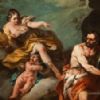Gaspare Diziani
(1689 Belluno - 1767 Venezia)
Coppia di dipinti
VENERE NELLA FUCINA DI VULCANO/ VENERE E NETTUNO
Olio su tela
90,5 x 101 cm cadauno
VENDUTI
I due dipinti correlati, in cui gli elementi fuoco e acqua sono tematizzati allegoricamente, facevano già parte di un ciclo decorativo, completato dai motivi aggiuntivi "aria" e "terra". In base alle dimensioni, è probabile che i dipinti siano stati inseriti come sovrastrutture in sale di rappresentanza molto alte o nella sala principale di un palazzo italiano.
Stilisticamente le rappresentazioni sono riconducibili al maestro di Diziani, Sebastiano Ricci, di cui erano note anche le incisioni. Secondo il tema e in linea con la tradizione, Venere è qui raffigurata su un delfino tra le onde, con uno sguardo rispettoso verso il dio del mare, che sta in piedi in una conchiglia e si china gentilmente verso di lei. Il velo della dea dell'amore è tenuto alto da un putto. Nell'altra tela, invece, Venere appare fuori dalla caverna della fucina tra le nuvole mentre tiene in mano un vaso di bronzo, probabilmente realizzato da Vulcano. Anche qui appare come mediatore un ragazzo- cupido che indossa un elmo. Entrambi i dipinti mostrano Venere che placa le forze della natura.
I due dipinti sono di alta qualità, corrispondente ad un'esigenza di arredo cortese, da intendersi anche per quanto riguarda l'ex pensile alto.
Diziani è stato a lungo considerato il più importante successore del suo maestro Sebastiano Ricci (1659-1734). Dal 1717 soggiornò a Dresda, nominato da agosto III. Nel frattempo, nel 1718, nella Residenza di Monaco furono realizzati quattro sopraporte, successivamente lavorò a Roma e Venezia. I due figli di Diziani, Antonio (1737-1797) e Giuseppe (1744-1821), lavorarono con lui nelle sue commissioni più impegnative.
English:
The two related paintings, in which the elements fire and water are allegorically thematized, were probably formerly part of a decorative cycle, complemented by the additional motifs of "air" and "earth". Corresponding to the size, the pictures are likely to have been integrated as overraports in very high state rooms or the main hall of an Italian palazzo.
Stylistically, these representations can be traced back to Diziani's teacher, Sebastiano Ricci, from whom engravings were also known. Following the theme and its tradition, Venus is here depicted on a dolphin in waves, with a respectful look towards the sea god, who stands in a shell and graciously leans towards her soothingly. The velum of the goddess of love is held high by a putto. In the opposite, Venus appears outside the forge cave in clouds while she is holding a bronze vessel, probably made by Vulkan. Here, too, a cupid boy with a helmet appears as a mediator. In a sense, both paintings show the gesture of appeasing the forces of nature through Venus, who in the latter picture prefers the beautiful jug object to the war helmet.Those two paintings present a really high quality, corresponding to a courtly furnishing requirement, which is also to be understood with regard to the former high room hanging.
Diziani has long been regarded as the most important successor to his teacher Sebastiano Ricci (1659-1734). From 1717 he stayed in Dresden, appointed by August III. In the meantime, four over-portals were created in the Munich Residence in 1718, and he later worked in Rome and Venice. Diziani's two sons Antonio (1737-1797) and Giuseppe (1744-1821) worked with him on his extensive commissions.


.jpg&larg=100&alt=100)
.jpg&larg=100&alt=100)


